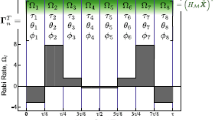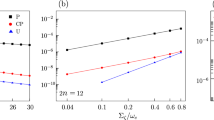Abstract
In this paper, we discuss how to reduce the interference that noise introduces into the scalar input signal of a quantum gate. Non-separable quantum gates can be made by making a small potential change to the Hamiltonian and then using perturbation theory to figure out the evolution operator. It is assumed that a scalar, temporally varying signal modulates the potential. To lessen the impact of noise on the design of the gate, we here take into account an extra noise component in the input signal and process it with a linear time-invariant filter. In order to meet these requirements, the Frobenius norm of the difference between the realized gate and the theoretical gate is minimized while taking into account the energy of the signal and the energy of the filter. Results from a computer simulation have been obtained by discretizing the resulting equations. The simulation results show that the proposed method effectively reduces the impact of noise on the gate design and improves its performance. This approach can be useful in designing gates for various applications, including signal processing and communication systems.
Similar content being viewed by others
Explore related subjects
Discover the latest articles, news and stories from top researchers in related subjects.Data availability
There are no associated data with my manuscript.
References
Griffiths, D.J.: Introduction to Quantum Mechanics, 2nd edn., pp. 261–367. Pearson Hall (2005)
Feynman, R.P.: Simulating physics with computers. Int. J. Theor. Phys. 21, 6–7 (1982)
David, D.: Quantum theory, the Church–Turing principle and the universal quantum computer. Proc. R. Soc. Lond. A 400, 97–117 (1985)
Shor, P.W.: Polynomial-time algorithms for prime factorization and discrete logarithm on a quantum computer. SIAM J. Comput. 26(5), 1484–1509 (1997)
Kato, T.: Perturbation Theory for Linear Operators, 2nd edn. Springer-Verlag, Berlin Heidelberg New York (1980)
Yongdan, Y., Bing-Nan, L., Li, Ying: Accelerated quantum Monte Carlo with mitigated error on noisy quantum computer. PRX Quantum 2, 040361 (2021). https://doi.org/10.1103/PRXQuantum.2.040361
Cheung Waterloo, D.: Using generalized quantum Fourier transforms in quantum phase estimation algorithms (2003)
Dirac, P.A.M.: The principal of quantum mechanics, 4th edn., pp. 108–178. Oxford University Press (1958)
Nielsen, M.A., Chuang, I.L.: Quantum Computation and Quantum Information, pp. 171–286. Cambridge University Press (2000)
Harrow, A.W., Hassidim, A., Lloyd, S.: Quantum algorithm for solving linear systems of equations. Phys. Rev. Lett. 15(103), 150502 (2009)
Ralph, T.C., Gilchrist, A., Milburn, G.J., Munro, W.J., Glancy, S.: Quantum computation with optical coherent states. Phys. Rev. Lett. A 68, 042319 (2003)
Zhang, W., Feng, D., Gilmore, R.: Coherent states—theory and some application. Rev. Modern Phys. 62, 867–927 (1990)
Cleve, R., Ekert, A., Macchiavello, C., Mosca, M.: Quantum algorithms revisited. Proc. R. Soc. Lond. A 454, 339 (1998)
DiVincenzo, D.P.: Two-bit gates are universal for quantum computation. Phys. Rev. A 51, 1015 (1995)
Cheung, D.: Using generalized quantum Fourier transforms in quantum phase estimation algorithms. University of Waterloo (2003)
Harrow, A.W., Hassidim, A., Lloyd, S.: Quantum algorithm for solving linear systems of equations. Phys. Rev. Lett. 15(103), 150502 (2009)
Perelomov, A.M.: Generalized Coherent States and their Applications, Texts and Monographs in Physics, pp. 7–39. Springer-Verlag (1986)
Ralph, T.C., Gilchrist, A., Milburn, G.J., Munro, W.J., Glancy, S.: Quantum computation with optical coherent states. Phys. Rev. Lett. A 68, 042319 (2003)
Gautam, K., Rawat, T.K., Parthasarathy, H., Sharma, N., Upadhyaya, V.: Realization of the three-qubit quantum controlled gate based on matching Hermitian generators. Quantum Inf. Process. 16(5), 113 (2017)
Barratt, F., Dborin, J., Bal, M., Stojevic, V., Pollmann, F., Green, A.G.: Parallel quantum simulation of large systems on small NISQ computers. npj Quantum Inf. 7, 79 (2021)
Paris, M.G.A.: Quantum estimation for quantum technology. Int. J. Quantum Inf. 07(01), 125–137 (2009)
Ferrie, C., Granade, C.E., Cory, D.G.: How to best sample a periodic probability distribution, or on the accuracy of Hamiltonian finding strategies. Quantum Inf. Process. 12, 611–623 (2013). https://doi.org/10.1007/s11128-012-0407-6
Sun, J., Lu, S., Liu, F., Zhou, Q., Zhang, Z.: Generalized relation between fidelity and quantum adiabatic evolution. Quantum Inf. Process. 14, 1757–1765 (2015). https://doi.org/10.1007/s11128-015-0972-6
Schirmer, S.G., Kolli, A., Oi, D.K.L.: Experimental Hamiltonian identification for controlled two-level systems Phys. Rev. A 69, 050306(R) (2004)
Deutsch, D., Jozsa, R.: Rapid solution of problems by quantum computation. R. Soc. Lond. Proc. A 439, 553–558 (1992)
Pino, J.M., Dreiling, J.M., Figgatt, C., Gaebler, J.P., Moses, S.A., Allman, M.S., Baldwin, C.H., Foss-Feig, M., Hayes, D., Mayer, K., Ryan-Anderson, C., Neyenhuis, B.: Demonstration of the trapped-ion quantum CCD computer architecture. Nature 592(7853), 209–213 (2021). https://doi.org/10.1038/s41586-021-03318-4
Clark, C.R., Tinkey, H.N., Sawyer, B.C., Meier, A.M., Burkhardt, K.A., Seck, C.M., Shappert, C.M., Guise, N.D., Volin, C.E., Fallek, S.D., et al.: High-fidelity Bell-state preparation with 40Ca+ optical qubits. Phys. Rev. Lett. 127, 130505 (2021)
Kumar, P.: Direct implementation of an N-qubit controlled-unitary gate in a single step. Quantum Inf. Process. 12, 1201–1223 (2013)
Altafini, Claudio: On the generation of sequential unitary gates from continuous time \(Schr\ddot{o}dinger\) equations driven by external fields. Quantum Inf. Process. 1, 207–224 (2002)
Xie, Tianyu, Zhao, Zhiyuan, Xu, Shaoyi, Kong, Xi., Zhiping, Wang, Yang, Mengqi, Wang, Ya., Shi, Fazhan, Du, Jiangfeng: 99.92 percentage—Fidelity CNOT gates in solids by noise filtering. Phys. Rev. Lett. 130, 030601 (2023)
Gautam, K., Sharma, N., Rawat, T.K., Parthasarathy, H.: Realization of commonly used quantum gates using perturbed harmonic oscillator. Quantum Inf. Process. 14, 3257–3277 (2015)
Kumar, G., Navneet, S., Tarun, K.R., Harish, P., Garv, C.: Realization of quantum gates based on three-dimensional harmonic oscillator in a time-varying electromagnetic field. Quantum Inf. Process 14, 3279–3302 (2015)
Ostmeyer, J.: Optimised Trotter decompositions for classical and quantum computing. J. Phys. A Math. Theor. 56, 285303 (2023). https://doi.org/10.1088/1751-8121/acde7a
Green, Todd, Uys, Hermann, Biercuk, Michael J.: High-order noise filtering in nontrivial quantum logic gates. Phys. Rev. Lett. 109, 020501 (2012). https://doi.org/10.1103/PhysRevLett.109.020501
de Lima Silva, T., Borges, L., Aolita, L.: Fourier-based quantum signal processing (2022). (arXiv:2206.02826 [quant-ph])
Postler, L., Heuben, S., Pogorelov, I., Rispler, M., Feldker, T., Meth, M., Marciniak, C.D., Stricker, R., Ringbauer, M., Blatt, R., et al.: Demonstration of fault-tolerant universal quantum gate operations. Nature 605, 675 (2022)
Author information
Authors and Affiliations
Corresponding author
Ethics declarations
Conflict of interest
On behalf of author, the corresponding author states that there is no conflict of interest.
Additional information
Publisher's Note
Springer Nature remains neutral with regard to jurisdictional claims in published maps and institutional affiliations.
Rights and permissions
Springer Nature or its licensor (e.g. a society or other partner) holds exclusive rights to this article under a publishing agreement with the author(s) or other rightsholder(s); author self-archiving of the accepted manuscript version of this article is solely governed by the terms of such publishing agreement and applicable law.
About this article
Cite this article
Gautam, K. Reducing the effect of noise on quantum gate design by linear filtering. Quantum Inf Process 23, 364 (2024). https://doi.org/10.1007/s11128-024-04575-8
Received:
Accepted:
Published:
DOI: https://doi.org/10.1007/s11128-024-04575-8




